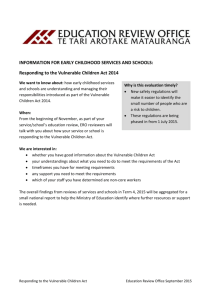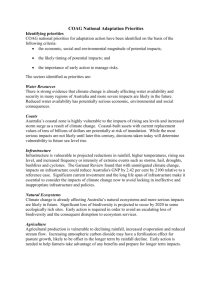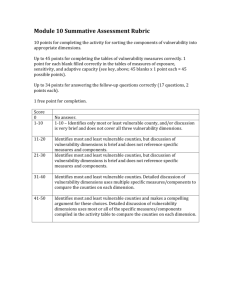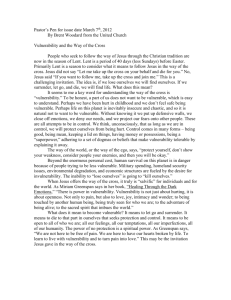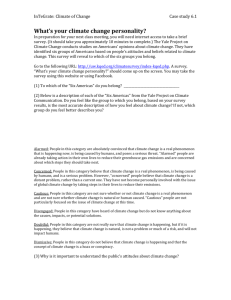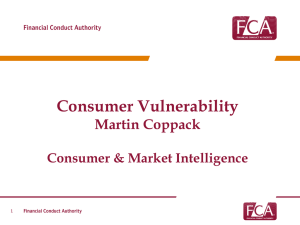A Climate Change Vulnerability Assessment for Hampshire
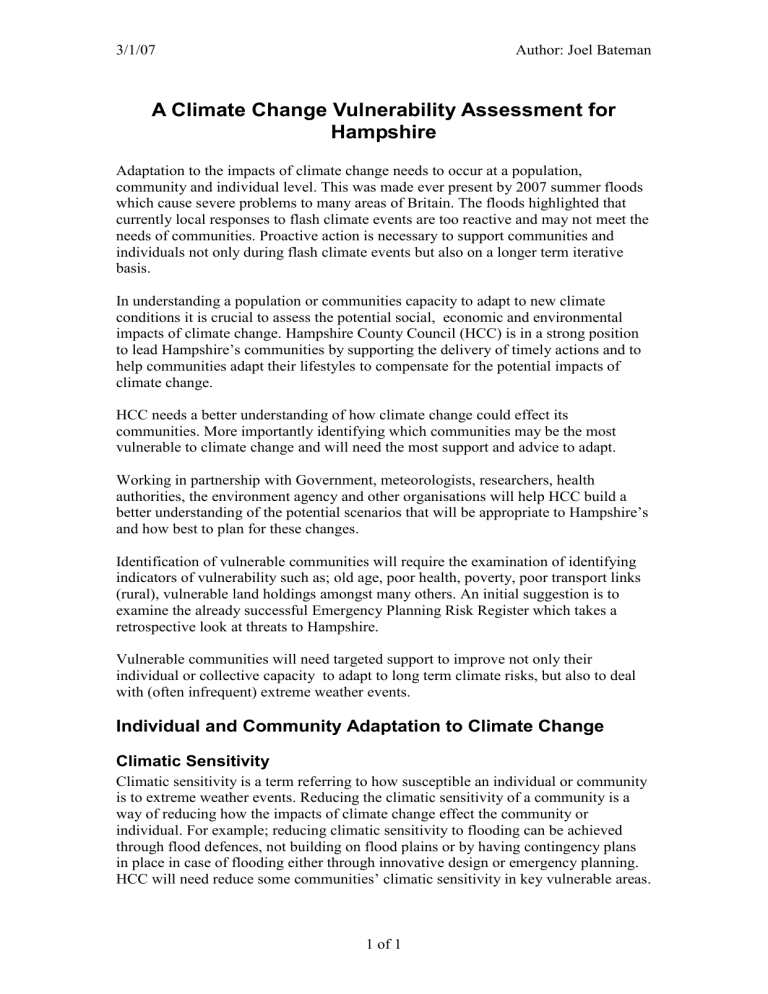
3/1/07 Author: Joel Bateman
A Climate Change Vulnerability Assessment for
Hampshire
Adaptation to the impacts of climate change needs to occur at a population, community and individual level. This was made ever present by 2007 summer floods which cause severe problems to many areas of Britain. The floods highlighted that currently local responses to flash climate events are too reactive and may not meet the needs of communities. Proactive action is necessary to support communities and individuals not only during flash climate events but also on a longer term iterative basis.
In understanding a population or communities capacity to adapt to new climate conditions it is crucial to assess the potential social, economic and environmental impacts of climate change. Hampshire County Council (HCC) is in a strong position to lead Hampshire’s communities by supporting the delivery of timely actions and to help communities adapt their lifestyles to compensate for the potential impacts of climate change.
HCC needs a better understanding of how climate change could effect its communities. More importantly identifying which communities may be the most vulnerable to climate change and will need the most support and advice to adapt.
Working in partnership with Government, meteorologists, researchers, health authorities, the environment agency and other organisations will help HCC build a better understanding of the potential scenarios that will be appropriate to Hampshire’s and how best to plan for these changes.
Identification of vulnerable communities will require the examination of identifying indicators of vulnerability such as; old age, poor health, poverty, poor transport links
(rural), vulnerable land holdings amongst many others. An initial suggestion is to examine the already successful Emergency Planning Risk Register which takes a retrospective look at threats to Hampshire.
Vulnerable communities will need targeted support to improve not only their individual or collective capacity to adapt to long term climate risks, but also to deal with (often infrequent) extreme weather events.
Individual and Community Adaptation to Climate Change
Climatic Sensitivity
Climatic sensitivity is a term referring to how susceptible an individual or community is to extreme weather events. Reducing the climatic sensitivity of a community is a way of reducing how the impacts of climate change effect the community or individual. For example; reducing climatic sensitivity to flooding can be achieved through flood defences, not building on flood plains or by having contingency plans in place in case of flooding either through innovative design or emergency planning.
HCC will need reduce some communities’ climatic sensitivity in key vulnerable areas.
1 of 1
3/1/07 Author: Joel Bateman
However, many of the approaches necessary to reducing climatic sensitivity involve expensive major infrastructure which may be outside of HCCs remit (e.g. coastal flood defence). HCC has a role in reducing the sensitivity of communities to extreme weather events through good planning of the infrastructure and maintenance services it provides, but also through partnership working with Parishes, District and Unitary
Authorities, the South East England Regional Assembly, Government organisations like the Department of Food and Rural Affairs and other national and local organisations such as the Environment Agency.
Adaptive Capacity
Adaptive capacity refers to the how adaptable an individual or community is to dealing with extreme weather events and is directly linked to climate sensitivity.
Improving the adaptive capacity of individuals or communities reduces the impact of the extreme weather event. This includes how quickly a community or individual can recover following a disaster. The adaptive capacity of a community is a direct reflection of social, economic and environmental indicators for example: communities with high unemployment, environmental contamination and social problems are at a significant disadvantage to respond or recover from a disaster. Communities that are affluent, healthy, with a stable transportation, utility and communication infrastructure are in a far better position to cope with disaster (Pine, J, 2004).
Effective adaptive capacity is therefore dependent on strong educational, health, political and social support systems. HCC has a major role to play in improving the adaptive capacity of the most vulnerable people of Hampshire and this is where
HCC’s efforts should be focused.
Determining vulnerability
Determinants of population vulnerability to climate related threats include levels of material resources, socioeconomic factors, demographic factors, effectiveness of governance, quality of public health infrastructure, access to relevant local information and the pre-existing burden of disease or ill health (Woodward et al .,
1998). Vulnerability is therefore determined by individual, community, and geographical factors (IPCC 2001 Climate Change 2001: Working Group II: Impacts,
Adaptation and Vulnerability, ):
Individual factors:
health status - people with pre-existing cardiovascular disease, for example, may be more vulnerable to direct effects such as heat waves
socioeconomic factors - unemployment rate, crime rate, premature birth rate, school drop-out rate, average income - the poor are more vulnerable
demographic factors - the elderly are more vulnerable to heat waves or extreme cold and infants are more vulnerable to diarrhoeal diseases
access to information - including early warnings of extreme weather events, clear guidance on what to do in an emergency.
2 of 2
3/1/07 Author: Joel Bateman
Community factors may include:
integrity of water and sanitation systems and their capacity to resist extreme events
local food supplies and distribution systems
access to information, including early warnings of extreme climate events, good governance and procedure during the emergency
local disease vector distribution and control programmes
Geographical factors may include: o o o o coastal or flood plains developments are more vulnerable to the effects of flooding populations bordering current distributions of vector-borne disease particularly vulnerable to changes in distribution e.g. Lyme’s disease in the New Forest rural residents often with less access to adequate health care, and urban residents more vulnerable to air pollution and heat island effects environmentally degraded and deforested areas more vulnerable to extreme weather events e.g. Efford landfill site in the New Forest
Output
Vulnerability Assessment Map
Using community profiles reflecting the social, economic and environmental indicators (as identified above) it will be possible to map the locations of the most vulnerable communities in Hampshire.
Below is a representation (not based on factual information) of a potential vulnerability map highlighting the priority areas (red dots) for intervention and focused action – these areas might have highlighted flood risks, rural communities, infrastructure problem, large population of old age pensioners etc.
:
3 of 3
3/1/07 Author: Joel Bateman
Monitoring and Reviewing Achievements
Once communities have been prioritised, a focused action plan, to address the particular, vulnerabilities can be developed. Because climate change adaptation is an iterative process a vulnerability assessment should be repeated regularly to ensure that
Hampshire’s communities stand the best chance of adapting to the ever-changing threats of climate change.
Currently Government is pushing local authorities towards delivering sustainable communities. The process of developing vulnerability mapping and prioritising actions can be done as part of delivering sustainable communities.
Creating prioritised targeted action with regular reviews will put HCC in a strong position to lead community focused climate change action on a local scale. This is made ever more relevant with the Audit Commission moving towards Comprehensive
Area Assessment (CAA) – a scoring system on the running of local public services which also aims to be more relevant to local people by focusing on issues that are important to their community.
Recommendation:
Hampshire County Council needs to allocate sufficient resources for cross departmental and cross agency working to examine the social, economic, and environmental indicators (as identified above) of climate change risk with a view to highlighting key vulnerable communities and prioritise action.
References:
Pine, J, 2004: Hazard Vulnerability and Consequence Analysis:
Building Sustainable Communities. Department of Environmental Studies
Louisiana State University - http://www.csc.noaa.gov/vata/Jpine_VATII.pdf
Woodward, A., S. Hales, and P. Weinstein, 1998: Climate change and human health in the Asia Pacific region: who will be the most vulnerable? Climate Research , 11,
31-38.
IPCC, 2001: Climate Change 2001. Chapter 9 Human Health - Working Group II:
Impacts, Adaptation and Vulnerability
4 of 4
